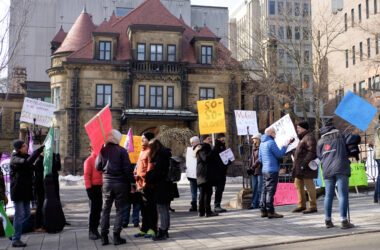
There is a point you reach in the middle of the winter when you realize that Montreal is not actually fit for human habitation. Usually it happens when you’re walking back from campus late at night. The wind is blowing, and even that pair of long underwear you’ve got underneath your jeans isn’t enough to stop the cold from reaching through to your flesh. As your eyelashes freeze together, you curse yourself for not having chosen UBC.
But during the winter, people often have to contend with more than just the cold. Getting through the day is not always as simple as having that extra helping of carbs in the morning, like stacking the proverbial logs on the fire to keep your body warm. Especially after two to three months of overcast weather, long hours of darkness, and forced hibernation inside your apartment or the library, it’s probably normal to be feeling a little under the weather.
But if you’re feeling more depressed than usual by the lingering winter weather, it’s possible that you’re also suffering from seasonal affective disorder (aptly abbreviated as SAD). Up to three per cent of Canadians suffer from SAD to the extent that it will affect their day-to-day life, despite not having pre-existing mental health problems. For those already suffering from some mental condition, 11 per cent will also develop symptoms of SAD.
The problem presented by a disorder like SAD is the tendency to dismiss it as an exaggeration. Almost everyone gets the blues in late January and February (usually around the end of Carnival). It’s a condition that people often deal with by self-prescribing medication (whether of the legal or illegal variety), so it tends to be particularly hard to tell whether your inability to get out of bed is the result of depression or just a hangover.
SAD’s symptoms manifest in a number of ways: a desire to avoid socializing, a persistent bad mood, depression, fatigue, oversleeping, and difficulty concentrating. These symptoms generally start to appear as daylight hours decrease in late autumn, and reach their peak by mid-January.
While having all this information is useful, most people probably won’t have to worry about being directly affected by SAD. However, knowing that winter is a real struggle for some people is definitely a way to gain perspective on the situation. Everyone has difficulty staying cheerful and motivated throughout the winter. But while we complain about icy sidewalks and chilly apartments, it’s important to remember that some people are having problems just climbing out of bed in the morning. In fact, some people have this problem year round.
So as McGill dives into midterm season, try not to get too down on yourself. Head outside and take advantage of the wet, snowball-quality powder, the longer hours of daylight and the coming spring. Don’t sulk through the remaining weeks of sleet and slush. Focus on the good things that you’ve got here. After all, you could be living in Kingston, Ontario.
Despite the average snowfall of about seven feet and the millions of dollars spent to clear and remove it from the city, the average low of -13 degrees Celsius and the thousands of winter jackets bought every year by residents trying to keep warm, Montreal could be worse. We’re not living at the North Pole, although it might feel that way sometimes. It won’t be winter here forever.








